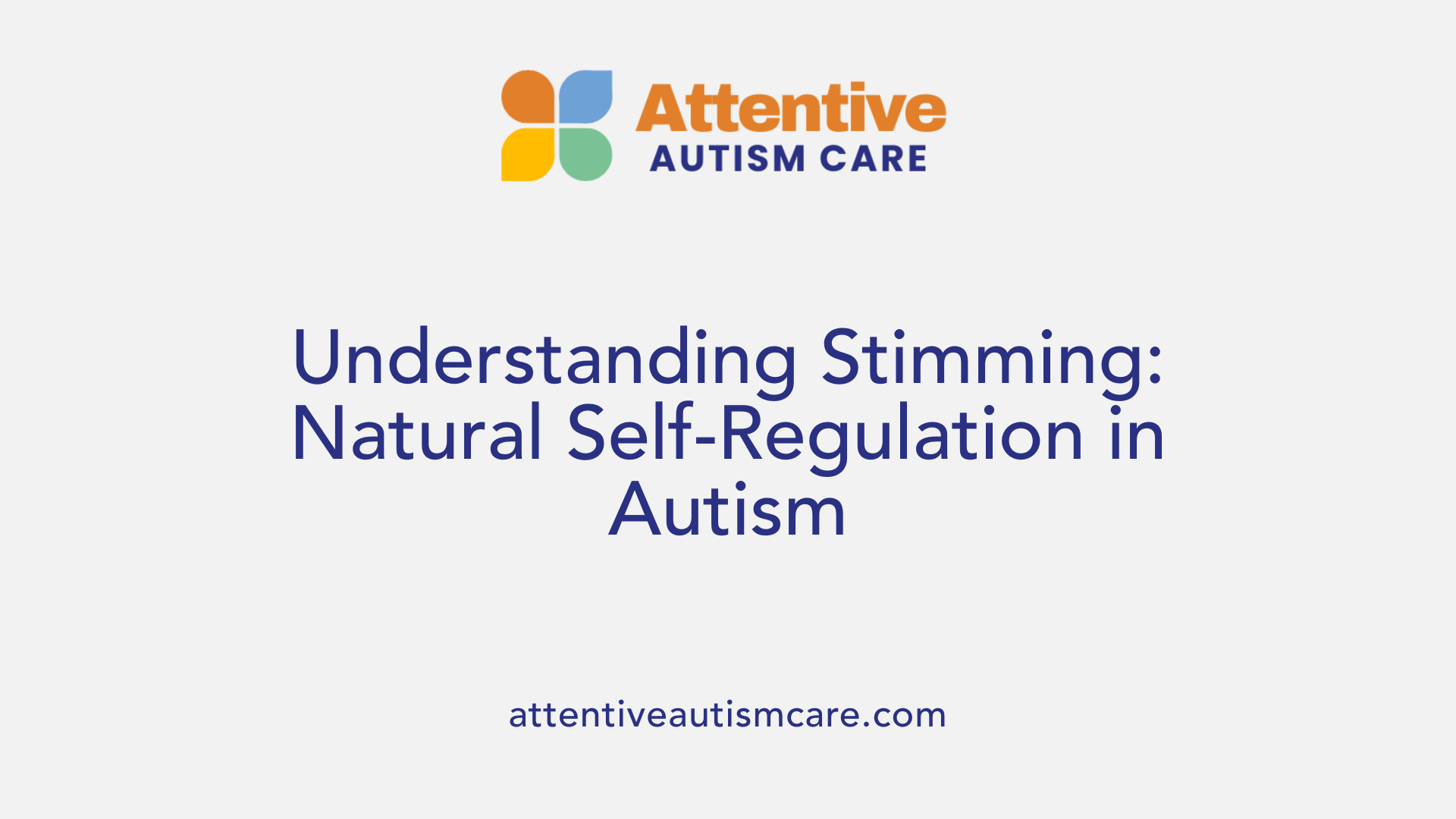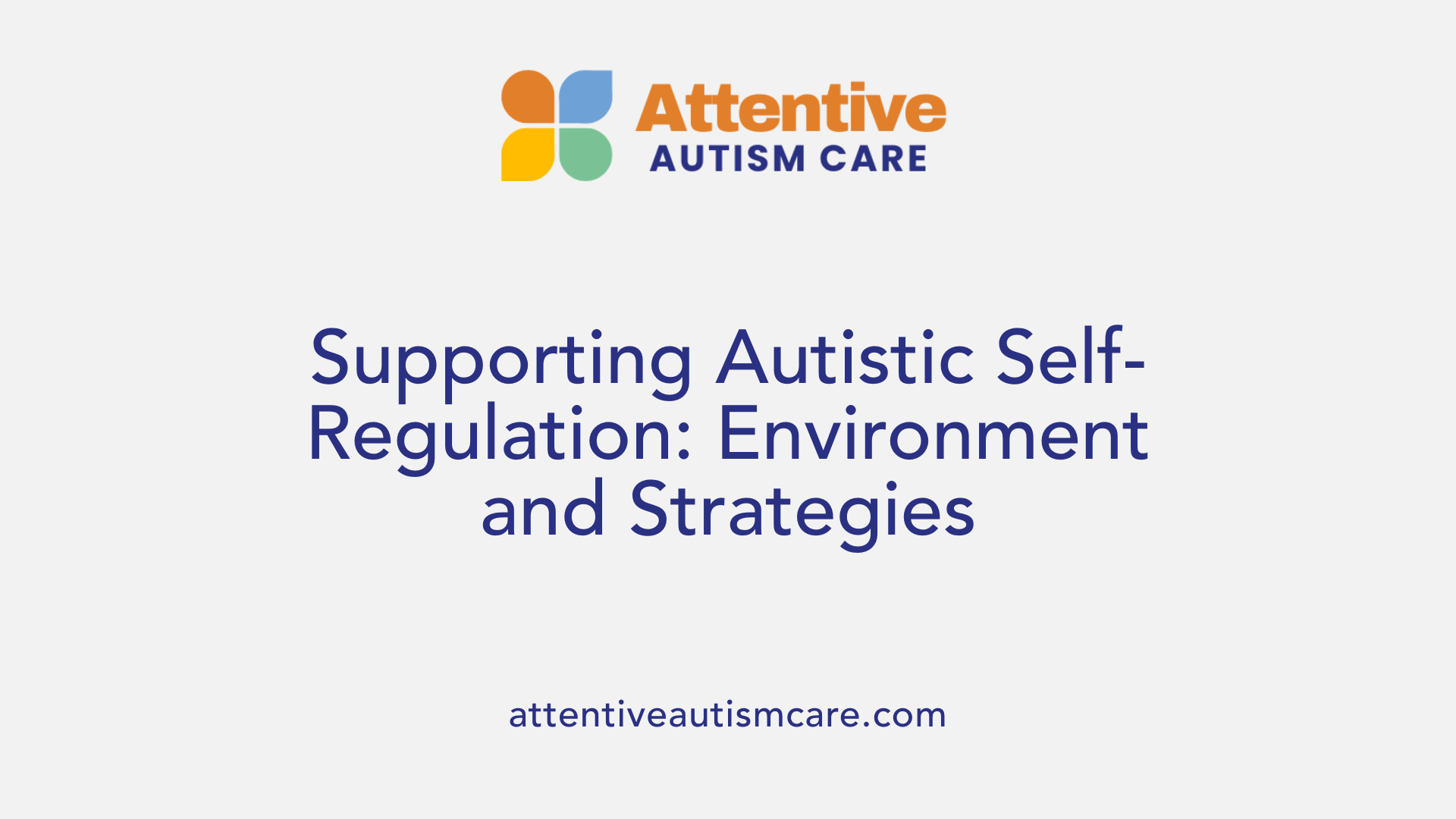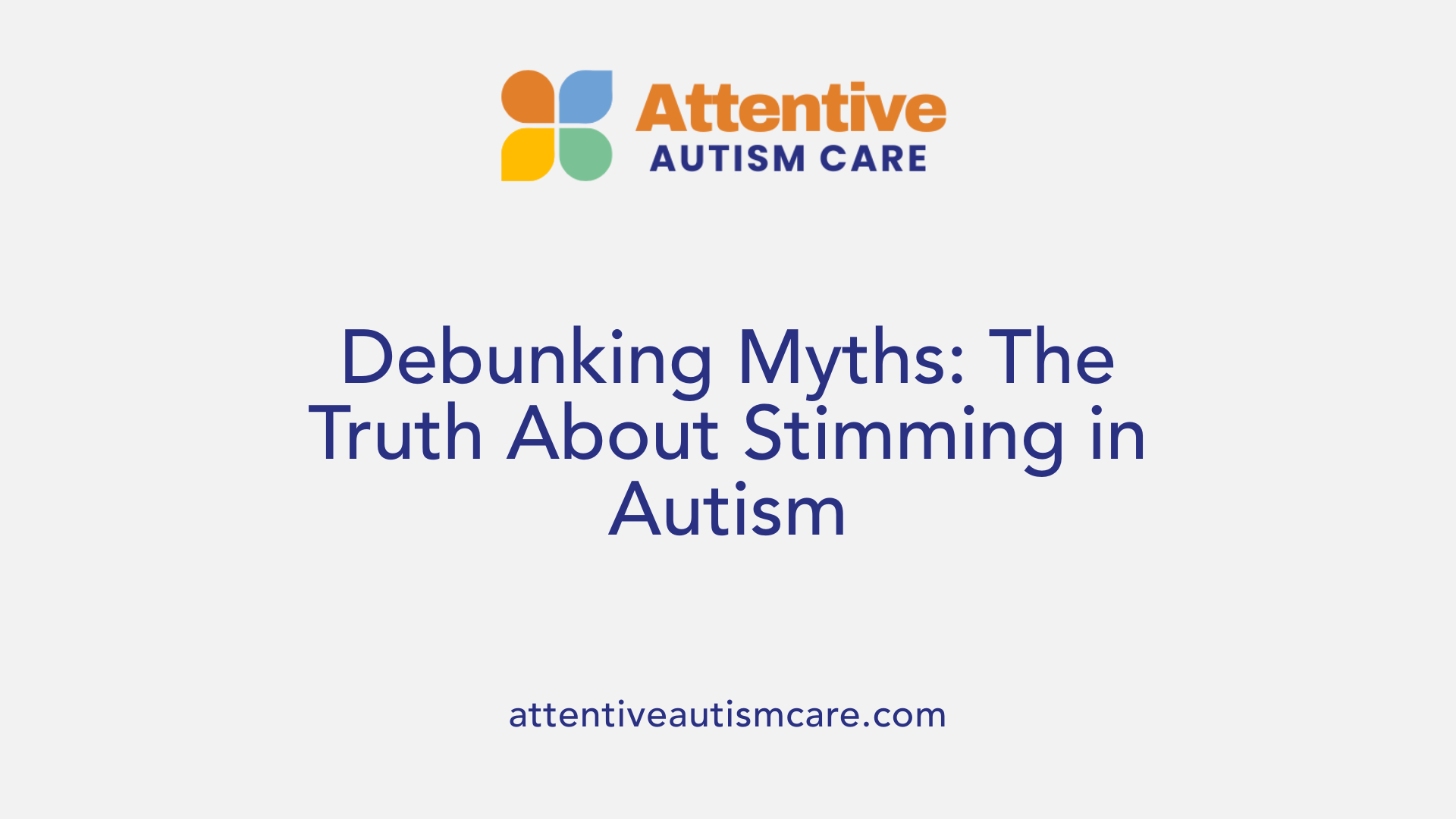Addressing Stimming Behaviors in Autism
Understanding and Supporting Sensory Behaviors in Autism

An Introduction to Stimming in Autism
Stimming behaviors are a hallmark feature of autism spectrum disorder (ASD), involving repetitive movements or sounds that serve various self-regulatory and emotional functions. Recognized in diagnostic criteria such as the DSM-5, stimming is a natural and often beneficial behavior for autistic individuals, aiding in managing sensory input and emotional states. This article explores the nature, significance, and strategies for supporting individuals with autism in relation to their stimming behaviors, emphasizing acceptance and effective intervention.
What Are Stimming Behaviors and Why Do They Occur?

What are stimming behaviors in autism, and why do they occur?
Stimming behaviors in autism are repetitive actions or movements, such as hand-flapping, rocking, spinning, or repeating words, that individuals often engage in to help regulate their sensory input and emotions. These actions typically start around age three and serve multiple purposes.
People with autism use stimming as a way to reduce anxiety, soothe themselves when overstimulated, or express emotions like excitement or frustration. It is a natural self-regulation method that helps manage their internal states and sensory experiences.
These behaviors can include movements like hand flapping, body rocking, jumping, or spinning, as well as vocalizations such as humming or repeating phrases. For some, they involve visual stimuli like watching spinning objects or lights.
While most stimming is harmless and aids in emotional and sensory regulation, some instances can be problematic or self-injurious. Despite this, completely stopping stimming is neither recommended nor possible, since it plays a vital role in how autistic individuals cope with their environment.
Understanding and accepting stimming as a core aspect of autism is crucial. It is more productive to support safe and appropriate stimming behaviors and provide alternatives when necessary, rather than attempting to eliminate these actions altogether.
In summary, stimming behaviors are essential for emotional well-being and sensory processing in many autistic people, serving functions like self-soothing, emotional expression, and sensory regulation.
Supporting Children and Teens with Autism in Managing Stimming

How can caregivers and educators support children and teenagers with autism in managing their stimming behaviors?
Supporting children and teenagers with autism in managing stimming involves creating environments that are understanding and accommodating. Recognizing stimming as a natural and functional behavior allows caregivers to foster acceptance rather than suppression. Offering safe, less disruptive alternatives—such as fidget toys, sensory objects, or encouraging vigorous physical activities—can help regulate sensory and emotional needs.
Understanding why a particular stim occurs is essential. Whether it’s to reduce sensory overload, manage stress, or express joy, addressing these underlying causes enables better support. Patience and gentle responses are crucial, avoiding exaggerated attention that might reinforce unwanted behaviors. Instead, redirect the behavior through positive reinforcement and teach alternative ways to cope.
Professionals like occupational therapists can aid in identifying effective strategies tailored to each individual. They may recommend sensory integration therapy or specific sensory diets to reduce the necessity for certain stimming behaviors. Overall, promoting autonomy, acceptance, and understanding equips children and teens with the tools to self-regulate effectively, fostering greater social inclusion and emotional well-being.
Misconceptions Surrounding Stimming in Autism

What are some common misconceptions about stimming in autism?
One of the most widespread myths about stimming in autism is the belief that all such behaviors should be completely suppressed. This misconception overlooks the fact that many stimming actions serve essential functions for autistic individuals. For example, stimming can provide vital sensory input, help manage anxiety, or allow emotional expression. People often see stimming as purposeless or disruptive, but in reality, it can help individuals cope with overwhelming environments, feelings of excitement, or nervousness.
Another common misunderstanding is the idea that all stimming behaviors are harmful or should be minimized. While some behaviors can be self-injurious or disruptive, most stimming is harmless and even beneficial. Attempting to eliminate or suppress these behaviors without understanding their purpose can cause emotional distress and exhaustion.
It’s also a misconception that masking or suppressing stimming helps autistic people fit in better socially. However, suppressing these behaviors can lead to increased stress, anxiety, and feelings of shame. Instead, understanding and accepting stimming as a natural part of autism fosters a supportive environment.
Why is acceptance of stimming important?
Acceptance of stimming respects the individual’s natural way of self-regulating and expressing themselves. It promotes mental well-being by reducing feelings of shame and frustration. Providing safe and appropriate alternatives for harmful behaviors, while supporting harmless stim activities, enhances quality of life.
Creating an environment where stimming is understood and accepted encourages self-confidence and helps autistic individuals develop coping strategies that work best for them.
How can we distinguish between harmful and harmless stimming?
Harmless stimming behaviors are generally repetitive movements or sounds that do not cause injury or interfere significantly with daily life. Examples include rocking, hand-flapping, or humming.
In contrast, harmful stimming might involve actions like biting, pressing on the eyes, or other self-injurious behaviors. These often require intervention and support from professionals.
Addressing dangerous behaviors involves understanding their function, managing triggers such as sensory overload or anxiety, and teaching safe, alternative behaviors.
Encouraging supportive environments and seeking expert advice helps ensure that stimming remains a positive and functional part of autistic self-expression.
| Aspect | Harmless Stimming | Potentially Harmful Stimming | Supporting Approaches |
|---|---|---|---|
| Definition | Repetitive behaviors without causing injury or disruption | Self-injurious or dangerous actions | Safe alternatives, environmental adjustments, professional input |
| Examples | Hand-flapping, spinning, rocking | Biting, pressing on eyes, head-banging | Sensory integration therapy, behavioral strategies |
| Impact | Usually beneficial or neutral | Can impair health or safety | Redirection, positive reinforcement |
Understanding the differences allows caregivers and educators to support autistic individuals appropriately, promoting safety and well-being while respecting their natural behaviors.
Types of Stimming and Their Impact on Daily Life
Are there different types of stimming behaviors, and how do they impact individuals with autism?
Stimming encompasses a wide range of behaviors that can serve various functions for individuals with autism. These behaviors are classified based on the senses involved, including visual, auditory, tactile, verbal, oral, olfactory, vestibular, and proprioceptive stimulations.
Visual stimming involves actions like watching spinning objects, patterns, or flashing lights. Auditory stimulations may include humming, listening to the same song repeatedly, or making repetitive sounds or phrases. Tactile behaviors consist of hand-flapping, rubbing fabrics, or touching objects in a repetitive manner. Oral stimming includes chewing or licking objects, while olfactory behaviors involve sniffing or smelling objects or substances.
Vestibular stim behaviors, such as swinging, spinning, or rocking, help regulate the sense of balance and spatial orientation. Proprioceptive stimming, like pressing on oneself or jumping, provides feedback from muscles and joints.
These behaviors can be mild, like tapping fingers or humming, or more intense, such as head-banging or pacing. Often, they serve vital roles: calming overstimulation, reducing anxiety, expressing excitement, or helping manage overwhelming sensory input.
Most stimming provides beneficial sensory regulation and emotional expression. However, some behaviors can become disruptive or hazardous. For example, head-banging or biting might cause injury, and behaviors so absorbing that they hinder learning or social interactions.
Environmental adjustments can support diverse stim behaviors. Creating quiet or sensory-friendly spaces allows safe expression. Using sensory tools like fidget toys or textured objects can channel more intense stim behaviors safely. Simple modifications, such as providing calming lighting or reducing noise, can lessen the need for certain types of stimming.
Recognizing the wide variety of stimming behaviors helps caregivers and professionals offer appropriate support. Acceptance of these behaviors, along with strategies for safety and comfort, encourages well-being and integration, allowing individuals to meet their sensory and emotional needs effectively.
Strategies and Interventions for Managing Stimming Behaviors
What are effective strategies for managing or reducing problematic stimming behaviors?
Managing or reducing problematic stimming behaviors requires a thoughtful and tailored approach that focuses on understanding the reasons behind the behaviors. Since stimming can serve functions such as sensory regulation, emotional expression, or stress relief, interventions aim to support these needs safely.
One of the first steps is to identify triggers, such as specific sensory inputs or emotional states. Adjusting the environment can be very effective; for example, creating calm spaces or reducing overwhelming sensory stimuli helps lessen the need to stim excessively.
Sensory integration activities are also useful. These include deep pressure input, vestibular stimuli, or proprioceptive inputs like swinging, jumping, or heavy work tasks. Using sensory tools such as fidget toys, textured objects, or weighted blankets provides alternative ways to satisfy sensory needs without disruptive behaviors.
Professionals like occupational therapists can develop personalized sensory diets that include specific activities aligned with an individual's preferences. Behavioral interventions, particularly Applied Behavior Analysis (ABA), are frequently used to teach alternative behaviors that serve the same function as problematic stimming but are less disruptive.
Techniques such as positive reinforcement are crucial. Rewarding the individual for engaging in safe, appropriate behaviors encourages more adaptive responses. Gradually, the frequency and intensity of harmful behaviors can be reduced while reinforcing positive coping methods.
Incorporating physical activity often helps decrease stimming frequency. Activities like running, dancing, or sports promote self-regulation and reduce the need for self-stimulatory actions.
Above all, support should be aimed at promoting emotional well-being and functional coping. Recognizing that stimming is a natural behavior, interventions are designed to redirect and substitute rather than eliminate completely. This approach respects the individual’s needs and promotes comfort and safety.
| Approach | Focus | Additional Details |
|---|---|---|
| Environmental modification | Reduce sensory triggers | Quiet spaces, sensory rooms |
| Sensory tools and activities | Satisfy sensory needs safely | Fidget toys, textured objects, weighted items |
| Behavioral therapy | Teach appropriate coping skills | ABA, reinforcement strategies |
| Physical activity | Reduce frequency of stimming | Running, jumping, dancing |
| Emotional support | Foster understanding and acceptance | Support groups, education |
Overall, a combination of these strategies centered on individual needs can effectively manage problematic stimming behaviors. This approach not only reduces disruptions but also supports personal growth and emotional health.
Fostering Acceptance and Well-Being through Understanding
Supporting individuals with autism involves recognizing the vital role of stimming in emotional regulation, sensory processing, and communication. While some behaviors may require intervention, the overall goal should be to promote acceptance and provide safe, appropriate alternatives that respect each person’s needs. By working collaboratively with professionals and using informed strategies, caregivers and educators can create environments that foster understanding, inclusion, and well-being. Embracing stimming as a natural part of autism helps reduce stigma, enhances mental health, and supports each individual’s unique pathway to self-regulation and happiness.
References
- Autism and Stimming
- Repeated movements and behaviour (stimming)
- Reducing Self-stimulatory Behaviors in Individuals with ...
- How To manage Stimming
- Stimming Behaviors and Treatment Ideas
- Stimming: autistic children and teenagers
- How To manage Stimming
- Stimming Behaviors and Treatment Ideas
- Strategies to Manage Verbal Stimming - Owl House Goa



































































































